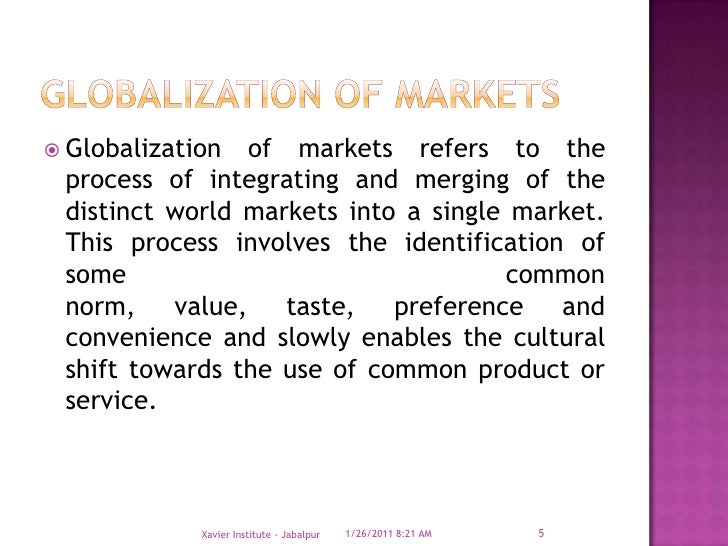Examples Of Market Drivers In Globalization Issues
Proponents of globalization argue that it allows poor countries and their citizens to develop economically and raise their standards of living, while opponents of globalization claim that the creation of an unfettered international free market has benefited multinational corporations in the Western world at the expense of local enterprises. Market Drivers. One of the primary drivers of globalization has been in respect to market forces, whereby many consumer goods and services are now universally available, no matter one’s geographic location or social setting. Structural drivers from the literature on globalization are summarized in Table One in terms of six categories: changes in technology, political forces, the rise of transnational corporations, market pull, support services, and competitive strategies.
Related Articles
- 1 Overseas Marketing Strategy
- 2 Globalization's Impact in Advertising
- 3 What Is the Key Feature of a Multinational Corporation?
- 4 The Advantages of Marketing Internationally

Marketing globalization is a synergistic term combining the promotion and selling of goods and services in an increasingly interdependent and integrated global economy. It makes companies stateless, without walls, with the internet an integral marketing and cultural tool. Understanding consumer needs within target countries helps formerly ethnocentric companies build a global marketing mix in which product, price, place and promotion are geared toward a specific country's needs.
Stocks Provide Reality Check
Nowhere is marketing globalism felt more than in the stock market. Stocks rise and plummet on the 'news' that a product or service is not faring well in some part of the world. Take crude oil as an example. If the cost per barrel rises, prompting gas prices to shoot through the roof, some stocks will still fall. If one country's political machine decries another nation's goods or services as bad, but societal demand runs rampant, stocks run amok. Marketers plan with damage control in mind. So they brand products and services, or get the name of the product or service known, to promote them in as many countries as possible. If they're smart, they target certain cultures, too.
Language Can Complicate the Mix
Product, price, place and promotion – known as the “four Ps of marketing” – become greater challenges when applied to global marketing. If your company's marketing efforts are constrained by keeping domestic and international marketing messages the same, your advertising may not translate well. For example, Colgate once marketed Cue toothpaste in France without knowing Cue was a well-known porn magazine. Clairol's Mist Stick backfired in Germany since 'mist' in German means 'manure.' And Italy's Traficante mineral water didn't fare well in Spanish-speaking countries because 'traficante' means 'trafficker.' No one can blame any unknown factor of international marketing for these missteps; they were caused by a simple lack of research.
Businesses Must Circumvent Constraints
So how does a business owner buffer the impact of globalization on business operations? Full immersion is the best way for marketers to get a feel for a target country. Take advantage of what is there — established storefronts, factories, workers — if it is in your company's budget to purchase local venues and to hire local workers. Understand the language and the slang; you can bet there are nuances galore. Research, exhaustively, what consumers want and need. And if budgetary constraints prevent full immersion in a target country, do the next best thing: immerse yourself virtually through social networking, online meetings and internet research.
Companies Evolve in Stages
Companies evolve into global markets in four stages: domestic, international, multinational and global. Marketing strategy begins domestically at the home office and goes international by extension, usually because the company decides to export its products. After products go international, marketing mixes must change or adapt to multinational strategies. The global framework then expands to emerging global markets, which can be unpredictable but opportunistic. Simply put: the domestic stage hosts the most controllable marketing strategies because the strategies play in one country only. Once you begin to market globally, you add more players to the mix. International adds exports, multinational adds companies on foreign soil and global is all of the above. Global marketing means that strategies must provide for volatile international markets and keep abreast of acquisition and logistical opportunities that affect the marketing mix.
References (5)
Resources (1)
About the Author
Cheryl Hosmer teaches online courses in writing and community journalism. She has written for various newspapers since 1983. She teamed up with author Marshall Terrill in 2001 as an editor of celebrity biographies. Hosmer holds a Bachelor of Arts in interdisciplinary studies from Madonna University. Her educational emphasis was poverty studies and journalism.
Photo Credits
- Photos.com/PhotoObjects.net/Getty Images